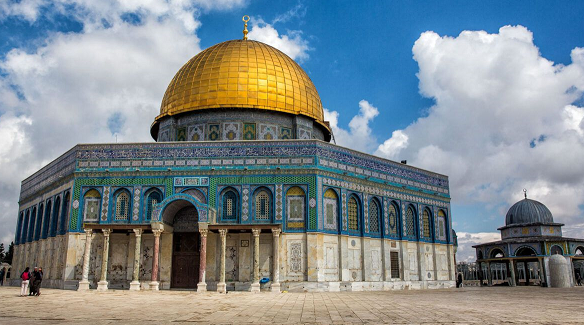Sacred Splendor: Unveiling the Dome of the Rock in Jerusalem

Perched atop Jerusalem’s Temple Mount, the Dome of the Rock stands as an emblem of spiritual significance and architectural grandeur. This iconic edifice, with its shimmering golden dome and intricate mosaics, has dominated the city’s skyline for over a millennium.
Built in the 7th century, it is one of the oldest extant Islamic structures, serving as a testament to the rich tapestry of religious and cultural histories intertwined in this ancient city. While it is a site of reverence for Muslims, who believe it marks the spot from which Prophet Muhammad ascended to heaven, its foundations are steeped in Judaic traditions, being the alleged location of Abraham’s intended sacrifice of Isaac. Beyond its religious connotations, the Dome of the Rock is a symbol of Jerusalem’s enduring spirit, a beacon that has witnessed empires rise and fall, yet remains unyielding in its majesty.
The iconic monument Dome of the Rock Jerusalem, often revered and regarded as the holiest edifices for both Jews and Muslims in Israel, has quite an intriguing history. The 14th-century Arab traveler Ibn Battuta once described this monument as “a building of extraordinary beauty, solidity, elegance, and singularity of shape.” Built atop a rock considered sacred by both Jews and Muslims around the world, the shrine plays a special dual role in the religious heritage of Judaism and Islam. According to Islamic texts, this was the site where Prophet Muhammad is said to have ascended to Heaven. This site is also where the biblical figure Abraham nearly sacrificed his son Isaac to prove his devotion, according to Jewish texts. Here are ten more such fascinating facts about the structure and its heritage:
Also Read:- 10 Best Historical Marvels of Europe
1. It was originally not a mosque | Dome of the Rock Jerusalem
And scholars are still debating its spatial function. The structure has been mistaken to be a mosque many times although its spatial identity is widely disputed. Like the Ka’ba in Mecca, it was built over a sacred stone and has been identified as a shrine. The rock is called the Foundation Stone and is made of limestone.es
2. Credit wars
While it was proven that the Umayyad caliph Abd Al-Malik commissioned the shrine, the latter Abbasid caliph Al-Mamun tried taking his credits by replacing Al-Malik’s name with his name in the commemorative inscription. However, Al-Mamun conveniently forgot to change the date, retaining the rightful credit to Al-Malik.
3. The design – A complex amalgamation | Dome of the Rock Jerusalem
The building was constructed between 688 and 691 CE under the patronage of the Umayyad caliph Abd Al-Malik. Malik, an Umayyad caliph, ordered his Byzantine architects to take inspiration from the Holy Church of Sepulchre, a sacred site of utmost importance in Judaism. This further proves the transcendence of built heritage through religion. The Sepulchre was built as a mixture of styles of Romanesque, Byzantine, and Baroque architecture, whose architectonic element such as the rotunda (termed the Anastasis in the Sepulchre) has been a prime inspiration in the design of Dome of the Rock.
4. The golden dome hasn’t been like that forever
Despite many misconceptions, the iconic dome, glittering in its glory, has been restored many times. Originally gilded, it has undergone multiple restorations, only to be recently gilded by the late King Hossein of Jordan.
5. The absence of a distinct entrance to the shrine | Dome of the Rock Jerusalem
Unlike many of its modern-day successors which have prominent and ornate entrance gates, the Dome of the Rock doesn’t have one. Instead, it has, according to scholars Manwarul Islam and Zaid Al-Hamad, “four small, almost invisible, doors and the lack of ‘marked facade conveying a hierarchy of form and function”.
6. The motifs and details are speculated to depict paradise, according to Islamic texts
The portion above the arches in the dome of rock have been bedecked with mosaic tiles only in the 16th century. Before that, when the structure was built there, this portion, in particular, was adorned with glass tiles having typical vegetal motifs, trees, and buildings as symbols of a paradise.
7. It was the only building with an octagonal plan form, that had any significance – for almost a thousand years!
During the time of construction of the Dome of the Rock (7th century CE), there were very few built forms with distinct religious identities. What is even more surprising is the fact that the octagonal plan form was and remains unique. The structure started an epoch of Islamic architecture and has acted as the architectural progenitor of all Islamic structures to come. Elements such as Arabic inscriptions, geometric motifs, and mosaic tiles are typical features carried on as legacies in future Islamic build forms.
8. Openings and religious symbolism | Dome of the Rock Jerusalem
The dome has been designed with the intent of concealing the Foundation Stone from most spaces inside the building. The sacred rock is visible only when one is near it, with the rock glowing under the cylindrical shaft of light beaming through the openings in the upper drum. According to historian Oleg Grabar (1996, 107), ‘This may mean that the building was planned in such a way that the specificity of the holy object — a rock to be touched or perhaps only seen — was replaced by the general evocation of something holy but almost invisible, a secret shared by the faithful, an invisible presence consciously designed into the building.’
9. The presence of an underground cave
Underneath the rock lies a rock-cut chamber called the Well of Souls. The chamber is said to be a spot where the souls of the deceased anticipate Judgement Day. The chamber consists of two Mihrabs installed by the Umayyads and the Fatimid empires respectively, and very few are allowed to enter this place.
10. The absence of minarets | Dome of the Rock Jerusalem
Although the shrine’s plan is considered a blueprint of all the mosques to come, it surprisingly doesn’t have any minarets! This can be attributed to its ambiguous spatial function during the initial stages of its construction.








